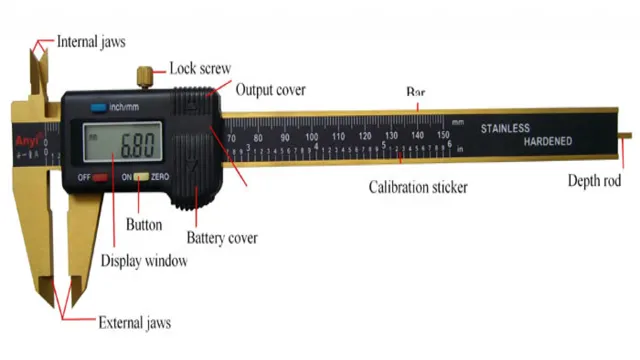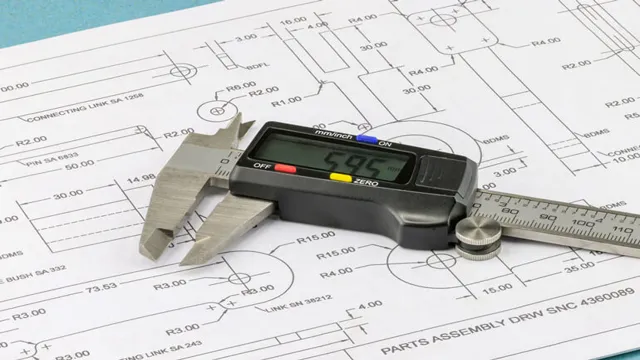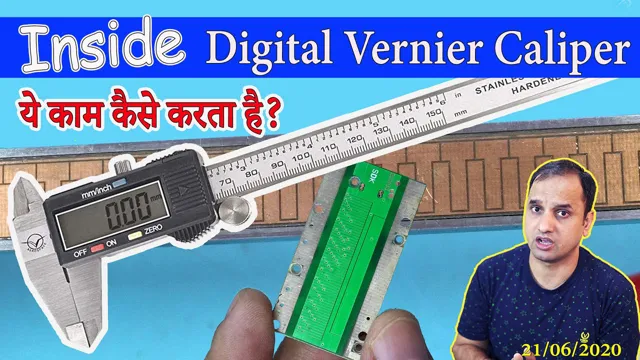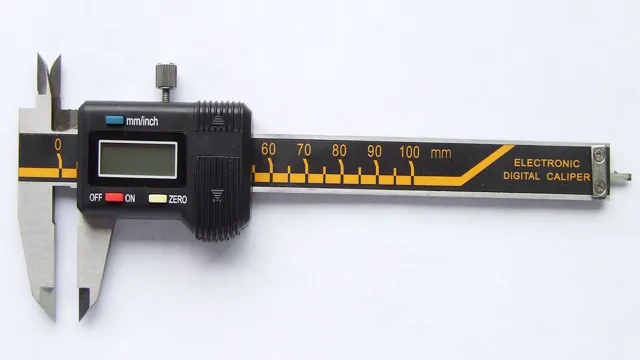How to Use a Digital Caliper: A Beginner’s Guide to Accurate Measurements
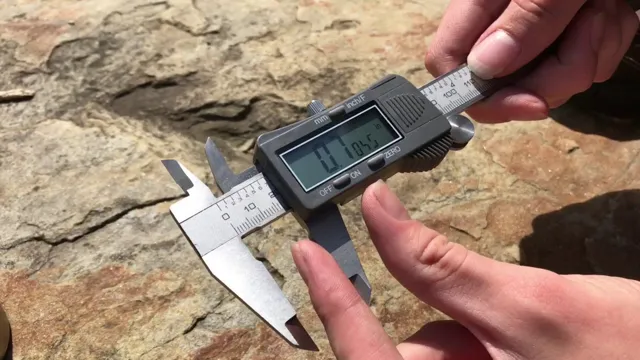
Have you ever needed to get precise measurements for a project but struggled with getting accurate results? Using a digital caliper could be the solution to your problem. This handy tool is easy to use and provides precision measurements for a variety of different applications. Whether you are an engineer, craftsman, or just someone who enjoys DIY projects at home, a digital caliper is an essential tool to add to your toolkit.
In this blog post, we will discuss everything you need to know about using a digital caliper, from how it works to the different types available. So, grab your caliper and let’s get started!
What is a Digital Caliper?
A digital caliper is a tool used to take precise measurements of small objects with accuracy up to thousandths of an inch or millimeter. Unlike traditional calipers, which rely on analog readings and require manual interpretation of the measurements taken, digital calipers display readings directly on a digital screen. To use a digital caliper, simply close the jaws around the object being measured, read the measurement from the display, and record it as needed.
It’s essential to ensure that the object is held firmly between the jaws of the caliper and that the display is set to show the desired unit of measurement. Some digital calipers offer additional features, such as the ability to zero out the display to take differential measurements or to measure depth. By learning how to use a digital caliper properly, it’s possible to take highly accurate measurements that would be difficult or impossible to obtain with other tools.
Whether you’re working on a DIY home project or carrying out scientific experiments, a digital caliper is an essential tool that can make your life easier.
Definition and Types
A digital caliper is a precision tool used for measuring small distances with very high accuracy. It combines a ruler and a vernier scale with an electronic digital display to provide fast and accurate measurements. Digital calipers come in different types, such as the standard digital caliper, the dial caliper, the electronic caliper, and the depth gauge.
The standard digital caliper is the most common type and is used for measuring the outer diameter, inner diameter, and depth of an object. The dial caliper is used for measuring the thickness of an object, while the electronic caliper features a larger display and can memorize readings. Lastly, the depth gauge is used for measuring the depth of a hole or a slot.
Overall, digital calipers are versatile and precise tools that are widely used in fields such as manufacturing, engineering, and machining.
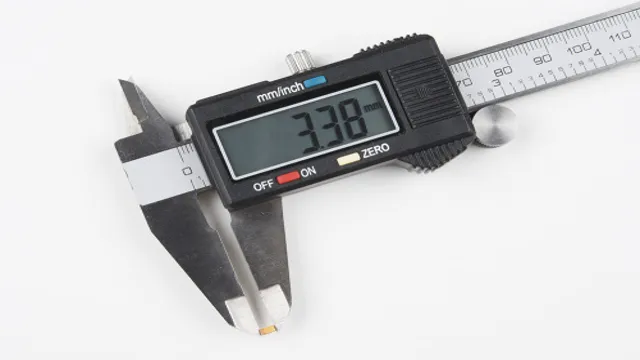
Parts of a Digital Caliper
A digital caliper is an essential tool for measuring precise dimensions that are difficult to measure with traditional tools. It is a device that can measure lengths, diameters, and depths with incredible accuracy, down to the thousandth of an inch or hundredth of a millimeter. This tool consists of three main components, the first being the jaws.
These are the two prongs that extend from the base of the caliper and are used to grasp the object being measured. The second main component is the scale. This is a graduated ruler that is used to measure the distance between the jaws, and can be either digital or analog.
The third component is the digital display, which shows the measured value on the screen in a clear and concise manner. The combination of these three components makes digital calipers an incredibly useful tool for anyone who needs to measure precise dimensions. Whether you are a machinist, engineer, or hobbyist, a digital caliper should be an essential part of your toolkit.
How to Use a Digital Caliper
If you’ve never used a digital caliper before, it can be a bit overwhelming at first. But don’t worry – it’s actually quite easy to use once you know what you’re doing. First, turn it on and make sure it’s set to zero.
Then, place the jaws around the object you want to measure and slowly tighten them until they’re snug. The digital display should show the measurement in either inches or millimeters, depending on your preference. Remember to always read the measurement from the main scale, not the sliding scale.
If you need to take multiple measurements, simply release the jaws and repeat the process. It’s important to keep the caliper clean and dry to ensure accuracy. With a little practice, you’ll be a pro at using a digital caliper in no time!
Step-by-Step Guide with Pictures
Digital Caliper If you’re new to using a digital caliper, don’t worry! In just a few steps, you’ll be able to use one with ease. First, ensure that the caliper is properly zeroed out by placing the jaws together and pressing the zero button. Next, select the unit of measurement you want to use, such as inches or millimeters, on the display screen.
You can then use the jaws to measure either inner or outer dimensions, as well as depth or step measurements. Simply slide the jaws over the object you want to measure and read the result on the display screen. When you’re finished, turn off the caliper to conserve battery life.
With a little practice, you’ll be using a digital caliper like a pro in no time!
Taking Measurements with a Digital Caliper
Digital Caliper When it comes to precise measurements, a digital caliper is a handy tool to have in your arsenal. To use it, start by firmly gripping the caliper and placing the jaws around the object you want to measure. The digital display will show you the exact measurement in either inches or millimeters.
Make sure the object remains still while you take the measurement, as any movement could lead to inaccurate results. If you need to measure depth, use the smaller jaws on the bottom of the caliper and gently push down until you reach the bottom of the object. With a digital caliper, you can take measurements with ease and accuracy for a variety of tasks, from woodworking to automotive work.
Switching Between Units of Measurement
Switching Between Units of Measurement with a Digital Caliper If you’re working on a project that requires precise measurements, a digital caliper can make all the difference. Not only does it allow you to measure to the thousandth of an inch, but it also makes it easy to switch between different units of measurement. Whether you need to switch from inches to millimeters or vice versa, all you need to do is press a button.
The caliper will instantly adjust to the new unit, so you don’t have to waste time converting manually. Think of it like a bilingual person switching between languages. Just as a person might switch from speaking English to Spanish depending on who they’re talking to, a digital caliper can switch from inches to millimeters depending on the measurements you need to take.
And just as a bilingual person can effortlessly switch between languages, a digital caliper can effortlessly switch between units of measurement. So, if you’re working on a project that requires precise measurements and need to switch between different units of measurement, a digital caliper can make it easy. It’s like having a multilingual tool in your workshop, ready to switch languages at the press of a button.
Tips for Using a Digital Caliper
Digital calipers are helpful tools that provide accurate measurements for a variety of projects. But if you’re new to using them, you may feel a bit overwhelmed. Don’t worry – it’s simpler than it seems! First off, make sure your caliper is set to the correct units of measurement.
Next, practice using the different measurement modes, such as inside and outside jaws, and depth gauge. Remember to always zero the caliper before taking a measurement. This ensures accuracy and consistency.
When measuring, use a gentle pressure and keep the caliper straight and parallel to the object being measured. Lastly, take your time and double-check your measurements to avoid mistakes. With these tips and a bit of practice, you’ll be a pro at using a digital caliper in no time!
Maintenance and Care
Maintaining and caring for your digital caliper is essential to ensure accurate measurements and prolong its lifespan. Here are some tips that will help you get the most out of your tool. Firstly, always keep your caliper clean and dry.
Any debris or moisture can affect the accuracy of your readings. Secondly, avoid dropping or knocking your caliper as this can damage its delicate components. Thirdly, store your caliper somewhere safe, such as in its protective case.
Fourthly, regularly replace the battery and ensure the battery compartment is clean and free from any corrosion. Finally, ensure that the jaws and measuring surfaces are handled with care and not damaged. By following these simple tips, you can ensure your digital caliper serves you well for years to come.
Accuracy and Precision Tips
A digital caliper is an essential tool for measuring very small distances and ensuring accuracy and precision. However, to use a digital caliper correctly, there are some tips that one must follow. First, make sure that the caliper is fully closed before turning it on.
This ensures that it is calibrated to zero and provides an accurate measurement. Second, when measuring an object, use a steady hand and make sure that the object is sitting flush against the measuring surface. This will prevent any errors caused by incorrect placement.
Finally, take multiple readings and calculate the average measurement to ensure precision. By following these tips, you can ensure that your digital caliper provides accurate and precise measurements every time.
Conclusion
In conclusion, using a digital caliper is an art form that requires precision and attention to detail. Just like an artist meticulously paints a masterpiece, the user of a digital caliper must carefully measure and record their findings. However, unlike an artist, there is no room for improvisation when it comes to measuring with a digital caliper – accuracy is key.
So, remember to zero your device before each use, handle it with care, and always double-check your measurements. After all, the beauty of using a digital caliper lies in its perfect and uncompromising accuracy. Happy measuring!”
FAQs
What is a digital caliper and how does it work?
A digital caliper is a precision measuring tool used to measure the external and internal dimensions of an object. It works by using a sensor to convert the distance between two points into an electronic signal which is then displayed on a digital screen.
What are the advantages of using a digital caliper over a traditional caliper?
Digital calipers offer a number of advantages over traditional calipers, including increased precision, ease of use, and the ability to store and recall measurements. Digital calipers are also more resistant to wear and tear than mechanical calipers.
How do I calibrate my digital caliper?
To calibrate your digital caliper, you will need to first make sure that it is clean and free from dirt and debris. Then, use a standard gauge block to set the zero point on your caliper. Once the zero point is set, you can use the caliper to take accurate measurements.
What units of measurement can I use with my digital caliper?
Most digital calipers will allow you to switch between metric and imperial units, including millimeters, centimeters, inches, and feet.
Is it safe to use a digital caliper on electrical equipment?
Digital calipers are generally safe to use on electrical equipment, but it is important to take the necessary precautions to avoid damaging the equipment or injuring yourself. This may include wearing protective gloves and taking care not to touch any exposed wires or connectors.
How can I prolong the lifespan of my digital caliper?
To prolong the lifespan of your digital caliper, try to keep it clean and free from dirt and debris. You should also avoid dropping or impacting the caliper, and store it in a protective case when not in use.
Can I use my digital caliper to measure depth?
Yes, many digital calipers come with a depth gauge attachment which can be used to measure the depth of holes and other recessed areas. Simply attach the gauge to the end of your caliper and use it to take precise depth measurements.

